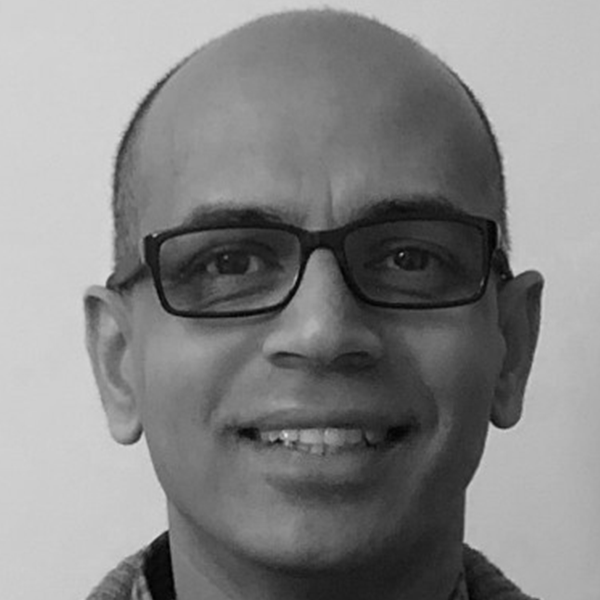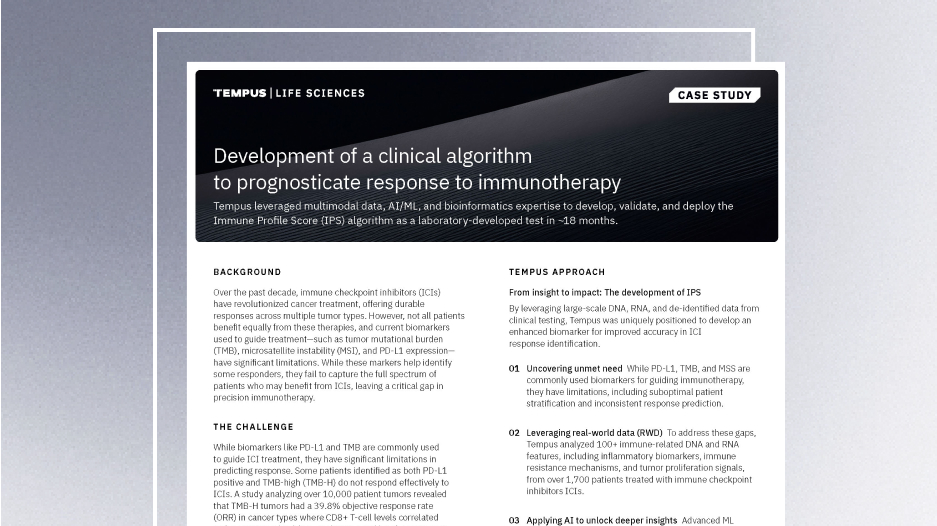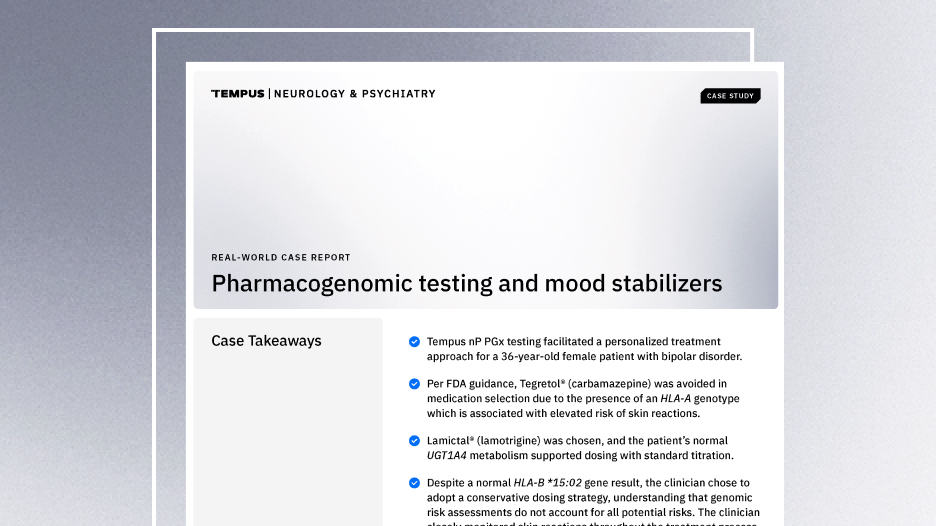-
PROVIDERS
Register now
Are you getting the full picture? A webinar series on the power of comprehensive intelligent diagnostics
-
LIFE SCIENCES
Enroll now
Tempus’ Patient-Derived Organoid ScreensEvaluate the efficacy of your preclinical compounds using fixed organoid panels designed for diverse therapeutic applications. Space is limited — enroll by June 30, 2025, to secure your spot.
-
PATIENTS
It's About Time
View the Tempus vision.
- RESOURCES
-
ABOUT US
View Job Postings
We’re looking for people who can change the world.
- INVESTORS
02/04/2025
Q&A: Navigating the outcomes research landscape
Tempus’ Senior Director and Head of Strategy, HEOR, Emilie Scherrer, MSc, recently led a webinar with industry experts to discuss the evolving landscape of outcomes research, focusing on real-world evidence (RWE) and advanced analytics.
Authors
Emilie Scherrer, MSc
Senior Director and Head of Strategy, HEOR, Tempus

Vadim Koshkin, MD
Associate Professor of Clinical Medicine, UCSF

Mark Stewart, PhD
Vice President, Science Policy, Friends of Cancer Research

Somnath Sarkar, PhD
Global Head of Evidence Generation and Decision Science, Sanofi

Senior Director and Head of Strategy, HEOR, Tempus

Vadim Koshkin, MD
Associate Professor of Clinical Medicine, UCSF

Mark Stewart, PhD
Vice President, Science Policy, Friends of Cancer Research

Somnath Sarkar, PhD
Global Head of Evidence Generation and Decision Science, Sanofi

The insightful session featured a panel that included Dr. Vadim Koshkin, MD, Associate Professor of Clinical Medicine at UCSF, Mark Stewart, PhD, Vice President of Science Policy at Friends of Cancer Research, and Dr. Somnath Sarkar, PhD, Global Head of Evidence Generation and Decision Science at Sanofi. The conversation centered on how integrating multimodal data can transform pharmaceutical research and healthcare decision-making as well as drive innovation and improve patient outcomes across the continuum of care.
|
“We must acknowledge the importance of standardizing data and collecting it meaningfully in outcomes research, as the saying ‘garbage in, garbage out’ holds true. Without high-quality, standardized, and diverse data, even the most advanced AI tools won’t yield reliable insights in the field.” – Mark Stewart, PhD, Vice President of Science Policy at Friends of Cancer Research |
The role of outcomes research in drug development, clinical practice, & healthcare policy
How have you applied integrated evidence planning in your current position at Sanofi and previous roles in biopharma and data analytics? |
| Somnath Sarkar, PhD: One of the most exciting aspects of outcomes research is its ability to support the entire drug development spectrum, from early-stage research to commercialization. Integrating real-world data (RWD) with clinical trial findings—a process known as integrated evidence generation—has the potential to expedite drug development and make the process more inclusive and sustainable. Historically, the different phases within biopharma have operated in silos. However, there’s been a recent shift towards a more cohesive approach, emphasizing integrated evidence planning. The challenge we face is dismantling these silos to bridge the gap between patient care and drug development, which is at the heart of integrated evidence generation.
Reverse translation is one method to achieve this, where RWD is applied at strategic points throughout a drug’s lifecycle. This approach is about translation and using patient data to enhance drug development and patient care at various stages. It’s widely recognized that the populations in clinical trials often differ from patients in real-world settings, and this discrepancy is significant. To bridge this gap, it’s essential to integrate RWD into development planning, including clinical trial design, to ensure proper representation. When considering representativeness, there are a variety of sub-efforts to examine. These include revising inclusion and exclusion criteria and addressing enrollment challenges. Solving these issues isn’t a matter of a single solution; it requires addressing multiple facets individually. Recent publications have shed light on these topics, and there is active work in this area. I believe leveraging RWD is crucial in addressing these challenges and is a key area where it can provide substantial support and insights. |
Dr. Stewart, could you share how your current projects are advancing the field and whether they incorporate elements of the strategies we’ve discussed? |
| Mark Stewart, PhD: One exciting development is the integration of multiple data sources—such as claims, genomic data, imaging, and patient-reported outcomes—to provide a more comprehensive understanding of treatments. At Friends of Cancer Research, our work is touching on various aspects of this. Somnath made a great point about the necessity of breaking down silos, and much of the work involves forming what might be described as ‘unnatural partnerships’—bringing together stakeholders who might not typically collaborate.
Moving forward, the ability to leverage data robustly and meaningfully will be crucial for developing more inclusive, data-driven, and patient-focused evidence. This requires collaboration among regulators, industry professionals, researchers, advocates, and patients to ensure that the outcomes are not only scientifically sound but also meaningful. |
Dr. Koshkin, how does outcomes research play a role in clinical practice, beyond the collaborative work undertaken with biopharma companies? |
| Vadim Koshkin, MD: Clinical trials, particularly Phase III, are considered the gold standard for evidence. However, they do not address all questions or capture the full clinical nuances of specific patient populations that emerge once a drug is approved. For these situations, retrospective studies and RWE become crucial.
So, recognizing that clinical trials are not designed to answer certain questions has led to a shift towards alternative methods of data generation to assess drug effectiveness in various patient populations. Typically, clinical trials are not representative of the overall patient population, mostly because of stringent criteria they may have. And even though that is often the case, researchers still complete accrual, gather a result readout, and hopefully receive drug approval. If it is approved, the drug is then used in a real-world, patient population, which is similarly nuanced. Another point to consider is the rapid pace of advancement in oncology and drug approvals. Many trials become somewhat outdated by the time they conclude because they were designed years prior, under different treatment landscapes. As new standards of care emerge, questions arise about the effectiveness of approved drugs in patients who have been exposed to newer treatments. RWE is critical for answering these questions, especially as the rate of oncology drug approvals accelerates and reliance on clinical trials alone is insufficient. |
Innovative approaches in outcomes research data integration & analytics
Could you elaborate on the initiatives Friends of Cancer Research has undertaken regarding response endpoints, and how they contrast with conventional clinical trial endpoints? |
| Mark Stewart, PhD: Our recent work has focused on identifying, characterizing, and evaluating various endpoints that can be extracted from RWD. This was motivated by the understanding that traditional endpoints captured in clinical trials may not be documented in the same manner in real-world settings. Our work has included a range of endpoints, from real-world overall survival (rwOS) to metrics like time to treatment discontinuation and time to next treatment, which is often more accessible from RWD than traditional measures such as response rate or progression-free survival (PFS).
One challenge in real-world settings is the variability in data capture. Unlike clinical trials, where response evaluation criteria in solid tumors (RECIST) are defined and applied, RWD may not always be recorded with the same level of precision. Clinicians may rely on qualitative assessments rather than strictly quantitative imaging measures, which can influence the interpretation of RWD. Despite these challenges, our work demonstrates that real-world endpoints provide unique value and insights into the performance of therapies. It’s essential to acknowledge the nuances in data capture and ensure transparency in defining, collecting, and measuring these endpoints to arrive at meaningful conclusions and advance the field responsibly. |
What are the key differences between physician-assessed responses and imaging-based responses, as compared to the RECIST criteria typically used in clinical trials? |
| Vadim Koshkin, MD: Investigator assessments are inherently less objective than centralized assessments of radiographic responses, even though this is not intentional. Of course, when clinicians are looking at a series of scans, they can make a more objective assessment of whether things look bigger or smaller. However, when you have a patient in front of you, and you’re considering the data from the scans, it allows for a lot more nuance. This can help capture a fuller picture of what’s happening with the patient. For example, treatments might not meet the strict RECIST criteria for a response and would be classified as stable disease, but if a patient who was significantly symptomatic before treatment is now doing much better and reports feeling better, it’s an indication that the treatment is likely effective.
Therefore, when comparing investigator assessments in RWD or clinical trials to centralized assessments, it’s important to be mindful that the numbers may not be directly comparable. Investigators might tend to overcall responses, likely reporting a higher percentage of responses than what a more strictly objective measure like RECIST would indicate. Still, capturing this clinical nuance is important, as it reflects the treatment’s impact on the patient’s well-being. |
How do you balance the use of qualitative insights, which may not be captured by scans, with imaging-based assessments? Are these qualitative data points being incorporated into your studies? |
| Somnath Sarkar, PhD: New endpoints must undergo a level of validation that is feasible and meaningful within the context of RWD. Creating a framework for this validation is crucial, although extreme validation across different databases may not always be possible due to variability. The strategy has been to focus on clinical validation, examining how these endpoints perform in real-world scenarios, like creating a target trial. This involves comparing them with RECIST-based endpoints and understanding the differences, which is essential for incorporating the endpoints into drug development use cases.
Another important aspect is using the FDA “Estimands and Sensitivity Analysis” framework published in 2017, which involves incorporating endpoints to account for various factors such as treatment and intercurrent events. Given that real-world studies differ from clinical trials, transparency is vital. For instance, scans are not typically done during scheduled visits, potentially affecting PFS assessments and hazard ratios. Understanding these impacts is crucial for drug development. It’s also worth noting that many biases may cancel out when comparing treatments within a real-world framework, particularly in comparative effectiveness studies. |
Trends in outcomes research
What are your thoughts on emerging technologies that hold promise in outcomes research, particularly with AI’s role in propelling the field forward? What strategies should we adopt to preserve scientific integrity and ensure patient privacy? |
| Somnath Sarkar, PhD: The focus should be on the end-to-end process of evidence generation, not just the tools used. This aligns with the idea of creating fit-for-purpose evidence, a concept that has been evolving over the past four or five years, influenced by foundational papers and work by the FDA and others.
One emerging area of interest is causal inference, which builds upon predictive modeling. It addresses the ‘What if?’ questions physicians often consider, such as the potential outcomes of treating a patient one way versus another. Causal inference aims to establish causality, not just make predictions, which has traditionally been the focus in real-world settings. Even traditional techniques, such as inverse probability weighting (IPW), can be integrated into this framework, which offers much to look forward to in the context of machine learning (ML) and deep learning. Vadim Koshkin, MD: It’s essential to remember that all these technologies are tools, and the quality of data is paramount. Currently, many retrospective real-world studies, particularly those using claims databases, may suffer from lower data quality due to a lack of granularity and detail. Much of the work involves traditional chart reviews, where relevant data is manually extracted, which is incredibly labor-intensive. A new tool capable of performing this task more efficiently, such as a language learning model, could significantly reduce the workload here. However, the success of these projects still depends on the information recorded in patients’ medical records and what is accessible. Mark Stewart, PhD: At a higher level, there is widespread recognition that integrating these tools into drug development can lead to significant gains in efficiency and provide new insights into data. When shifting towards using this data as evidence for regulatory bodies like the FDA, a different level of validation is required, which is currently a sticking point. The FDA’s recent meeting with their new Digital Health Advisory Committee touched on whether current regulatory frameworks are optimal for the latest generation of AI tools. The responses vary, but a common takeaway is that adaptations could improve the integration of these tools. |
How are you ensuring the patient’s voice is central to the design and execution of outcomes research, and what innovative methods have you employed to achieve this? |
| Vadim Koshkin, MD: Historically, the field has not sufficiently engaged patients in determining what endpoints are most relevant to them in clinical trials. Common assumptions have been made that metrics, like overall survival, toxicity, and tolerability, are more relevant than others.
However, balancing these against the cost of the drug, the trade-off between efficacy and toxicity, and other nuanced questions requires a patient’s perspective, which often differs from that of physicians and regulatory agencies. Increasingly, patient advocacy groups and disease-specific organizations, such as the Prostate Cancer Foundation or the Bladder Cancer Advocacy Network, are incorporating patients into their boards and discussions. This inclusion is crucial and should continue to ensure that clinical trials are aligned with patient priorities and perspectives. Mark Stewart, PhD: The inclusion of the patient’s voice in discussions is crucial, especially as we look to the future. The challenge lies not only in keeping pace with technology but ensuring that it is developed to serve patients, rather than the reverse. It’s easy to envision rooms filled with brilliant engineers discovering all the possibilities data can offer, yet it’s critical to have someone there considering the end goal. The key questions are whether these advancements will provide clinically meaningful and important information to physicians and patients, if they are actionable, or if they merely add to the confusion in an already complex environment. |
For future insights on outcomes research and to learn how Tempus is helping close care gaps with its extensive real-world clinical and molecular data, explore our data collaboration solutions.
*Note: content edited for clarity.
Please note that the content in this document has been revised for clarity and conciseness. Some language and formatting may have been adjusted to enhance readability while preserving the original meaning and intent of the discussion.
-
04/02/2025
Development of a clinical algorithm to prognosticate response to immunotherapy
Discover how Tempus developed and deployed the Immune Profile Score (IPS)—a powerful algorithm that provides prognostic insights into patient outcomes following treatment with immune checkpoint inhibitors (ICIs)—in ~18 months. This case study highlights the AI-driven methodology, real-world validation, and the impact of IPS in precision oncology.
Read more -
03/25/2025
AI & ML in action: Unlocking RWD with GenAI through Tempus Lens
Discover how Tempus is equipping researchers with innovative AI solutions to fully leverage the potential of multimodal data. Gain insights from a panel of leaders across healthcare and life sciences as they discuss the impact of these advanced tools on delivering insights with speed.
Watch replay
Secure your recording now. -
03/11/2025
Case Report: Pharmacogenomic testing and mood stabilizers
This real-world case demonstrates how the Tempus nP pharmacogenomic test facilitated a personalized treatment approach for a patient with bipolar disorder.
Read more


